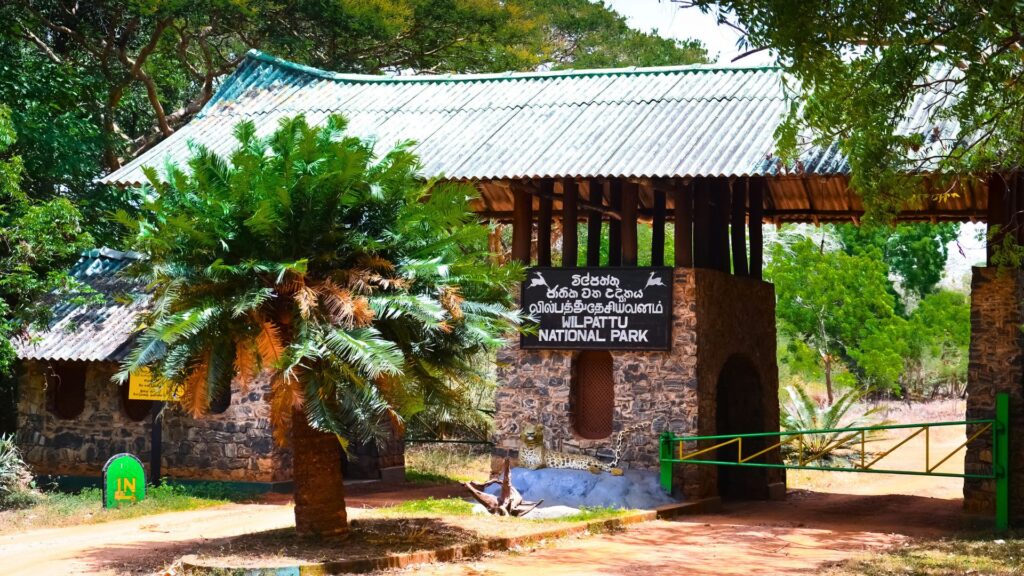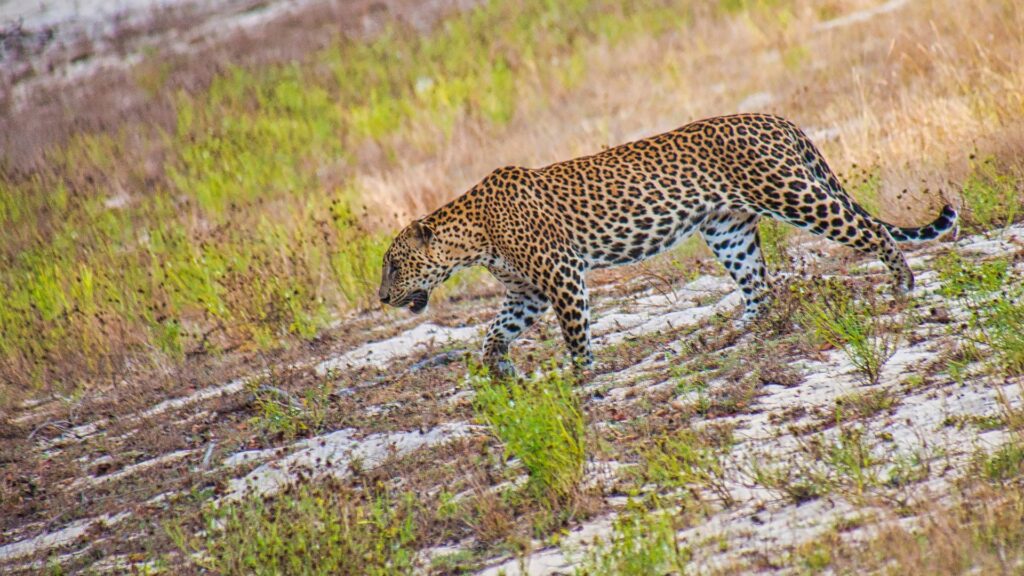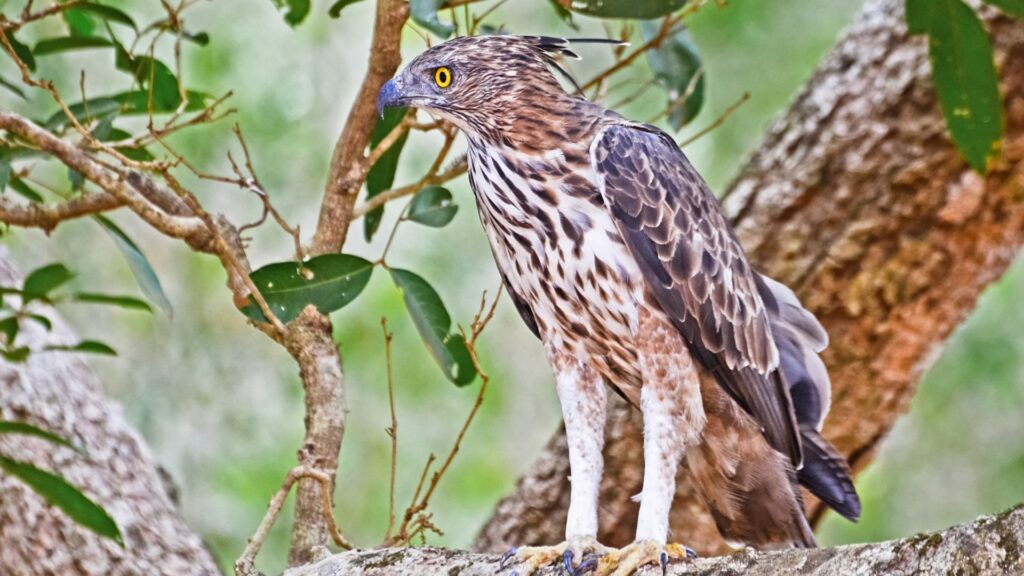Wilpattu National Park, the largest national park stands as a testament to Sri Lanka’s natural beauty and biodiversity, drawing in travelers from around the globe with its allure and reputation as a conservation hotspot.
Introduction to Wilpattu National Park’s Allure and Reputation

Wilpattu National Park, located in the northwestern part of Sri Lanka, captivates visitors with its unspoiled wilderness and diverse ecosystems. Spanning over 1,300 square kilometers, Wilpattu is renowned for its tranquil water bodies known as ‘villus’, dense forests, and vast grasslands, creating a picturesque setting for wildlife enthusiasts and nature lovers.
Brief History and Significance as a Conservation Hotspot
With a history dating back to ancient times, Wilpattu has been a sanctuary for wildlife and a revered place in Sri Lanka’s cultural heritage. It was formally designated as a national park in 1938, making it one of the oldest and largest parks in the country.
Wilpattu’s significance as a conservation hotspot stems from its role in protecting endangered species, preserving vital habitats, and promoting sustainable tourism practices.
What Makes Wilpattu a Must-Visit Destination for Nature Enthusiasts
Wilpattu’s appeal lies not only in its breathtaking landscapes but also in the incredible biodiversity it harbors. The park is home to a diverse range of wildlife, including the majestic Sri Lankan leopard, Asian elephant, Sloth bear, and a myriad of bird species.
For nature enthusiasts, photographers, and wildlife researchers, Wilpattu offers unparalleled opportunities to witness these iconic creatures in their natural habitat.
Moreover, Wilpattu’s serene ambiance, away from the bustling urban life, allows visitors to connect with nature on a deeper level. Whether you’re seeking thrilling wildlife encounters, adventurous safari jeep rides, or simply a peaceful retreat surrounded by nature’s splendor, Wilpattu promises an unforgettable experience for every nature enthusiast.
Navigating the Journey: How to Embark on the Wilpattu Expedition
Embarking on a journey to Wilpattu National Park in Sri Lanka can be an exhilarating experience filled with wildlife sightings and breathtaking landscapes. However, navigating the route to this natural wonder requires careful planning and knowledge of accessible routes and transportation options.
Accessible Routes
Wilpattu National Park is strategically located, making it accessible from various cities in Sri Lanka. Here are the accessible routes from key locations:
- Colombo: If you’re starting your journey from Colombo, the capital city, you have multiple options. The most common route is via Kurunegala and Puttalam, which offers well-maintained roads and scenic views along the way. Alternatively, you can take the coastal route via Negombo and Chilaw, which adds a touch of coastal charm to your journey (both routes rake ~ 4.5 hours with one stop for refreshments).
- Anuradhapura: For those traveling from Anuradhapura, the ancient city with rich historical significance, the route to Wilpattu is relatively straightforward (~1 hour drive). Head towards Puttalam from Anuradhapura, enjoying the countryside landscapes before reaching your destination.
- Nearby Cities: Other nearby cities like Puttalam and Mannar also serve as starting points for your Wilpattu expedition. From Puttalam, the park is just a short drive away (~ 1 hour), making it convenient for travelers staying in this area.
Diverse Transportation Options
Once you’ve decided on your starting point, it’s essential to choose the right mode of transportation for your journey. Here are the diverse transportation options available:
- Jeeps: Opting for a jeep safari is the most popular choice for exploring Wilpattu National Park. Several tour operators in Colombo, Anuradhapura, and nearby cities offer jeep rental services with experienced guides who can enhance your wildlife spotting experience.
- Buses: Public buses also provide access to Wilpattu (but only for the nearest small city, then you have to hire a tuk tuk or a jeep), especially from major cities like Colombo and Anuradhapura. While this option may take longer compared to a private vehicle, it’s budget-friendly and allows you to immerse yourself in the local travel experience.
- Guided Tours: If you prefer a hassle-free experience with all arrangements taken care of, consider booking a guided tour to Wilpattu. We can offer unforgettable tours with exciting experiences which include all transportation, accommodation, meals, and guided safaris, ensuring a comprehensive and enjoyable expedition. Furthermore if you choose to see the beauty of Wilpattu you can contribute to a conservation project in Sri lanka, which we always support responsible tourism as Zigma Tours.
Insider Travel Tips
To make your journey to Wilpattu smooth and memorable, here are some insider travel tips:
- Book in Advance: Whether you’re renting a jeep or joining a guided tour, it’s advisable to book in advance, especially during peak tourist seasons, to secure your spot and avoid last-minute disappointments.
- Pack Essentials: Don’t forget to pack essentials such as sunscreen, insect repellent, binoculars, water bottle and a camera with zoom capabilities to capture wildlife moments (dust mask will be really helpful during the fry spells).
- Respect Wildlife: When inside the national park, maintain a respectful distance from wildlife and follow guidelines provided by your guide to ensure both your safety and the animals’ well-being.
- Stay Overnight: Consider staying overnight near Wilpattu to experience both morning and evening safaris, increasing your chances of spotting elusive species like leopards and sloth bears.
The Enchanting Tapestry: Exploring Wilpattu’s Geographic Marvels
Wilpattu National Park in Sri Lanka is not just a haven for wildlife enthusiasts but also a treasure trove of diverse landscapes that weave together to create an enchanting tapestry of natural beauty.
Let explore the park’s mesmerizing geographic marvels, from its lush wetlands and sprawling grasslands to its unique villus and hidden gems that await discovery.
Immersive Description of Diverse Landscapes
- Wetlands: As you step into Wilpattu, you’re greeted by vast expanses of wetlands that glisten under the sun’s golden rays. These wetlands, comprising marshes, lakes, villus, and ponds, serve as crucial habitats for water-loving species such as water birds, crocodiles, and amphibians. The tranquil waters mirror the surrounding greenery, creating picturesque scenes that are a delight to behold.
- Grasslands: Moving deeper into the park, you encounter sweeping grasslands adorned with tall grasses swaying in the breeze. The open grasslands provide prime grazing grounds for herbivores like deer, buffalo, and elephants. It’s not uncommon to spot majestic herds meandering across these expansive plains, adding a touch of wilderness to the landscape. These grasslands often transition to unique Villu ecosystems.
- Villus: Among Wilpattu’s hidden gems are its villus, which are natural depressions or lakes scattered throughout the park. These villus are not just bodies of water; they are vibrant ecosystems teeming with life. From aquatic plants to fish and crustaceans, villus support a diverse array of flora and fauna, making them fascinating spots for wildlife enthusiasts and photographers.
Unveiling Hidden Gems and Unique Geographical Features
- Kudiramalai Point: Nestled within Wilpattu is the scenic Kudiramalai Point, a coastal area that offers breathtaking views of the Indian Ocean. This unique feature allows visitors to experience the convergence of terrestrial and marine environments, showcasing the park’s ecological richness.
- Natural Rock Formations: Throughout Wilpattu, you’ll encounter intriguing rock formations that add character to the landscape. These natural sculptures, shaped by centuries of geological processes, serve as vantage points for wildlife observation and offer a glimpse into the park’s geological history.
How Wilpattu’s Terrain Shapes its Biodiversity
The diverse terrain of Wilpattu plays a pivotal role in shaping its rich biodiversity and providing varied habitats for a wide range of flora and fauna. The wetlands support water-dependent species, while the savannas cater to grazers and predators alike. The villus act as oases of life, attracting an abundance of wildlife year-round.
Moreover, the park’s geographic features, such as dense forests and open plains, create microclimates that contribute to species diversity. From elusive leopards to colorful bird species and other endemic flora and fauna, Wilpattu’s terrain is a canvas upon which nature paints its masterpiece of biodiversity.
Wildlife Chronicles: Encountering Fauna & Flora Marvels

Wilpattu National Park in Sri Lanka is a wildlife enthusiast’s paradise, boasting a remarkable diversity of fauna and flora. Wilpattu is full of elusive leopards which is only second to Yala National Park for density and playful sloth bears.
And home to many endemic birds including Sri Lanka Spurfowl, Sri Lanka Junglefowl and Sri Lanka Woodshrike and other rare bird species that adorn the skies.
We’ll also share insider tips on where and when to spot these iconic creatures for an unforgettable safari experience, along with the ecological importance of Wilpattu’s flora and the ongoing conservation efforts to preserve this natural treasure.
A Detailed Showcase of main wildlife aspects of Wilpattu’s Biodiversity
- Leopards: Wilpattu is renowned for its population of majestic leopards, making it one of the best places in Sri Lanka to spot these elusive big cats. The park’s dense forests and rocky outcrops provide ideal habitats for leopards to thrive, although their stealthy nature often makes sightings a thrilling adventure.
- Sloth Bears: Another highlight of Wilpattu is its population of sloth bears, known for their shaggy coats and playful antics. These endearing creatures can often be spotted foraging for food in the park’s forested areas, adding a touch of charm to any safari experience.
- Rare Bird Species: Wilpattu is a birdwatcher’s paradise, home to a diverse array of avian species, including rare and endemic birds. Keep an eye out for the colorful plumage of the Sri Lanka Spurfowl, the majestic presence of the painted stork, and the melodious calls of the Malabar pied hornbill echoing through the trees.

Insider Tips on Wildlife Spotting
- Best Times for Wildlife Viewing: Early morning and late afternoon are prime times for wildlife sightings in Wilpattu. Animals are often more active during these cooler hours, increasing your chances of encountering them in their natural habitats.
- Hotspots for Leopard Sightings: Look out for areas with dense vegetation near water sources, as leopards are known to frequent these spots, especially during the dry season when water availability is limited.
- Sloth Bear Encounters: Keep an eye on areas with termite mounds and fallen trees, as sloth bears often search for insects and fruits in these locations. Patience and keen observation skills can lead to memorable sloth bear sightings.
The Ecological Importance of Wilpattu’s Flora and Conservation Efforts
Wilpattu’s flora plays a crucial role in supporting its diverse wildlife populations. From dense forests providing shelter to endemic plants offering food sources, the park’s ecological balance is intricately linked to its plant life.
Furthermore, ongoing conservation efforts, including habitat protection, anti-poaching measures, and community involvement, are vital in safeguarding Wilpattu’s biodiversity.
Conservation initiatives aim to preserve the park’s natural habitats, mitigate human-wildlife conflicts, and raise awareness about the importance of wildlife conservation among visitors and local communities.
Climate Odyssey: Navigating Weather Patterns for Optimal Adventures
Wilpattu National Park’s climate plays a significant role in shaping the ambiance of the park and influencing wildlife sightings. Here, we’ll provide a seasonal breakdown of weather patterns, highlight the best times to visit based on climate considerations and wildlife sightings, and offer an essential packing list along with smart tips to tackle each season’s challenges and delights.
Seasonal Breakdown of Weather Patterns
Monsoon Season (September to December):
- Ambiance: During the monsoon season, Wilpattu experiences heavy rainfall, which transforms the park into a lush green paradise. The wetlands brim with water, offering picturesque scenes and a boost in vegetation growth.
- Impact on Wildlife: While the dense foliage provides ample cover for wildlife, the increased water availability disperses animals across the park, making sightings more challenging.
- Visitor Considerations: Monsoon season is less crowded, offering a serene atmosphere for nature enthusiasts who don’t mind occasional rain showers.
Inter-monsoon Period (December to January):
- Ambiance: This transitional period sees a decrease in rainfall, leading to clearer skies and pleasant temperatures. The park retains its greenery from the monsoon, creating a vibrant backdrop.
- Impact on Wildlife: Wildlife sightings can be unpredictable during this time, with animals adjusting to changing weather patterns.
- Visitor Considerations: Ideal for those seeking a balance between fewer crowds and relatively stable weather conditions.
Dry Season (March to August):
- Ambiance: The dry season brings sunny days and cooler nights, showcasing Wilpattu’s savannas and open grasslands in their golden hues. Water sources become focal points for wildlife.
- Impact on Wildlife: Wildlife congregates around water sources, offering excellent opportunities for sightings, especially of large mammals like elephants and leopards.
- Visitor Considerations: Peak season for wildlife enthusiasts, but expect larger crowds and book accommodations and safaris in advance.
Best Times to Visit
- Wildlife Sightings: For optimal wildlife sightings, consider visiting during the dry season (May to September) when animals gather around water sources, increasing your chances of encountering a variety of species.
- Climate Considerations: The inter-monsoon period (December to January) offers a balance of favorable weather conditions and fewer crowds, ideal for a comfortable and immersive safari experience.
- Visitor Preferences: If you prefer a quieter ambiance and don’t mind occasional rain showers, the inter monsoon season (December to January) provides a unique perspective of the park’s lush landscapes which also envelop the birds’ migratory period.
Essential Packing List and Smart Tips
- Monsoon Season: Pack lightweight rain gear, waterproof footwear, insect repellent, and quick-drying clothing. Opt for early morning safaris for better visibility before rain sets in.
- Inter-monsoon Period: Include light layers, sunscreen, binoculars, and a camera with zoom capabilities. Be prepared for variable weather conditions.
- Dry Season: Bring sun protection (hat, sunglasses, sunscreen), comfortable clothing for warm days and cooler nights, a reusable water bottle, and a wildlife guidebook for species identification.
Regardless of the season you choose to visit Wilpattu, embracing the park’s diverse weather patterns adds an element of adventure to your safari experience.
By planning ahead, packing wisely, and staying adaptable, you can navigate Wilpattu’s climate odyssey and embark on optimal adventures amidst its natural wonders.
Harmony in the Wild: Dos and Don’ts for Responsible Exploration
Exploring Wilpattu National Park is not just about witnessing its natural beauty and wildlife; it’s also about fostering harmony between visitors and the environment.
We’ll outline essential dos and don’ts for responsible exploration, including respectful conduct guidelines towards wildlife and nature preservation, safari etiquette for a safe and memorable experience, and opportunities for community engagement and supporting conservation initiatives while exploring Wilpattu.
Respectful Conduct Guidelines
- Keep a Safe Distance: Respect the personal space of wildlife by maintaining a safe distance at all times. This not only ensures your safety but also minimizes stress on the animals. And you are not allowed to touch or collect any of the wildlife in National Parks.
- No Feeding or Interfering: Avoid feeding wildlife or attempting to interact with them. Feeding disrupts natural behaviors and can lead to dependence on human food, which is harmful to their health.
- Stay on Designated Trails: Stick to designated trails and paths to avoid trampling vegetation or disturbing habitats. Off-trail exploration can damage fragile ecosystems.
- Dispose of Waste Responsibly: Carry reusable water bottles and avoid single-use plastics. Dispose of waste in designated bins to keep the park clean and protect wildlife from ingesting harmful materials.
Safari Etiquette
- Respect Guide Instructions: Follow the instructions of your safari guide at all times. They are trained to ensure your safety and the well-being of the wildlife.
- Quiet Observation: Keep noise levels to a minimum during wildlife sightings. Loud noises can startle animals and disrupt their natural behaviors.
- Photography Ethics: Practice ethical wildlife photography by using zoom lenses to capture close-up shots without disturbing animals. Avoid using flash photography, especially near nocturnal species. Never ever alter or damage the ecosystem or habitats to get a good composition or frame.
- Stay Inside Vehicles: While on safari, remain inside your vehicle unless instructed otherwise by your guide. This helps maintain a safe distance from wildlife and prevents unnecessary disturbances.
Community Engagement and Conservation Initiatives
- Support Local Communities: Engage with local communities near Wilpattu by purchasing souvenirs or products made by local artisans. This supports sustainable livelihoods and fosters positive relationships between visitors and residents.
- Learn About Conservation Efforts: Educate yourself about ongoing conservation initiatives in Wilpattu and consider supporting organizations or projects dedicated to preserving the park’s biodiversity and habitats.
- Volunteer Opportunities: Some conservation organizations offer volunteer programs where visitors can actively participate in conservation activities such as habitat restoration, wildlife monitoring, or community outreach. If you inform us in advance we can arrange some volunteer activities for you as the Zigma Tours Team has a strong connection with most of the conservation activists in the country.
- Responsible Accommodations: Choose accommodations that prioritize eco-friendly practices such as waste reduction, energy conservation, re-use, recycling and support for local conservation initiatives.
By adhering to these dos and don’ts, visitors can ensure responsible exploration of Wilpattu National Park while contributing positively to conservation efforts and fostering harmony between humans and the wild.
Together, we can preserve this natural treasure for future generations to enjoy.
Join with Zigma Tours to be a responsible and respectable tourist who supports sustainable tourism and conservation.
